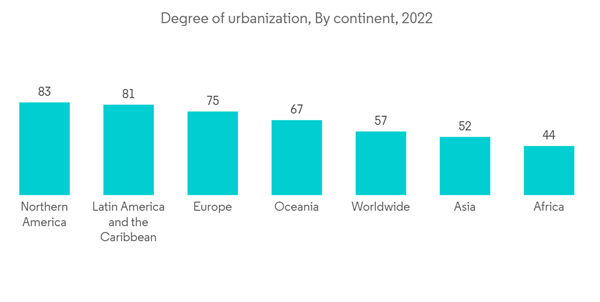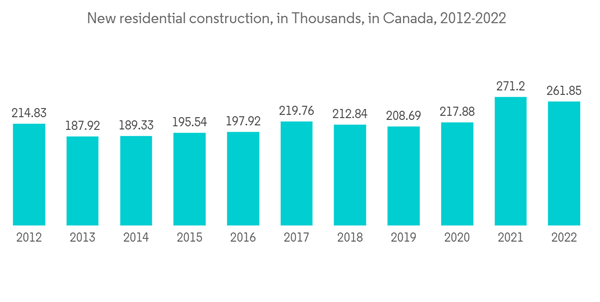Key Highlights
- Prefabricated construction accounts for nearly 20% of the US overall construction projects. The rising awareness of construction wastage and its impact on the environment is encouraging the adoption of prefabricated buildings globally. This factor is anticipated to bolster the market, predominantly in developed regions like the US.
- The COVID-19 pandemic has caused immense disruptions in construction works across North America. Manufacturing companies have faced a range of challenges owing to the shortage of raw materials. This is owing to the imposition of lockdowns across North America that resulted in disruptions in the supply chain. Trade in prefabricated buildings are minimal due to costs associated with shipping huge portions of building units over long distances. Many small, prefabricated building producers operate only in a limited geographic range, while larger producers have many production facilities spread across the US.
- The introduction of numerous government initiatives for promoting the construction of green buildings across the United States is also catalyzing the market. Moreover, the high prevalence of extreme cold weather in the region, leading to shorter days and heavy snowfall that inhibit on-site construction methods, is also propelling the need for modular construction. Nonresidential prefabricated building system demand in the US is expected to increase during the forecast period. The recovery in office and commercial construction, coupled with continued gains in institutional, industrial, and agricultural construction, will provide opportunities
North America Prefabricated Buildings Market Trends
Population Growth and Rapid Urbanization to Drive Demand for Prefabricated/Modular Construction in the US
In 2022, the degree of urbanization worldwide was at 57%. North America was the region with the highest level of urbanization, with over four-fifths of the population residing in urban areas.There is an increase in the urban population of the US. The estimated population of the US was approximately 339.96 Million in 2023. It continues to increase, and the country is the third most populous globally, behind China and India. California was the state with the highest population in 2023. Western parts of the US are the most urbanized, and the majority of cities and urban areas can be found here. The Northeast is also highly urbanized, with New York being the most populous city in the US.
In 2023, about 83.1% of the total US population live in cities and urban areas. As urbanization in the country is increasing, there is an increase in demand for buildings for residential and commercial purposes. This demand is giving a boost to prefabricated buildings. The rapid growth and development of urban housing require more precise planning timelines and reduced prices. Due to this, construction firms are adopting cost-effective, proven precast technologies to ensure the highest standards and uniform quality, which can be met by prefabricated technology, thus driving the prefabricated construction market.
Growth in Residential Construction Driving the Market
Limited mortgage rates, robust demand for larger living spaces, and a meager housing inventory in the market continue to boost the sector. Home renovation, in addition to home construction, is a significant aspect of residential construction.By 2023, the yearly value of residential building upgrades in the United States is expected to exceed USD 205 billion. More than 330,000 new rental units are scheduled to be supplied nationwide, comparable to the previous four years of a construction boom. Eight metros are expected to set five-year highs in new apartment deliveries, despite the pandemic's hurdles.
The continued expansion of the new home market implies that new homes are still being built, but mostly in locations where the market moves quickly. New York, Pennsylvania, and New Orleans are examples of this.
In March 2021, Canada's average home selling price increased by 31.6% Y-o-Y, setting a new high as sales rose to an all-time high. During the pandemic, record-low loan rates and a desire for greater room fueled demand for detached homes in smaller communities.
According to the Conference Board of Canada, low mortgage rates and strong population growth drive high home construction demand. In March 2021, residential construction investment climbed for 11 months, rising 7.6% to CAD 14.0 billion (USD 10.99 billion).
In the first quarter of 2021, total building construction investment increased by 9.3% to CAD 53.1 billion (USD 41.67 billion), owing to ongoing strength in the residential sector (+12.4%). Increased spending on single units in Ontario (+21.8%) and Quebec (+24.9%) boosted residential building investment to CAD 39.5 billion (USD 30 billion).
Following a 6.0% drop in the previous quarter, non-residential investment increased by 1.1% to CAD 13.6 billion (USD 10.2 billion) in the first quarter of 2021.
North America Prefabricated Buildings Industry Overview
The North American prefabricated buildings market is highly competitive with no major players. The market is expected to grow during the forecast period due to increased prefab construction building investments and upcoming major projects in the region.Major players operating in the market are implementing effective production technologies to minimize product costs and reduce related risks. High capital requirements and rapid technological advancements are important barriers to entry for new participants. However, the change in trends to support sustainability and ecological balance is giving rise to the rapid adoption of green modular building concepts, thus, providing opportunities to market players.
Additional Benefits:
- The market estimate (ME) sheet in Excel format
- 3 months of analyst support
This product will be delivered within 2 business days.










